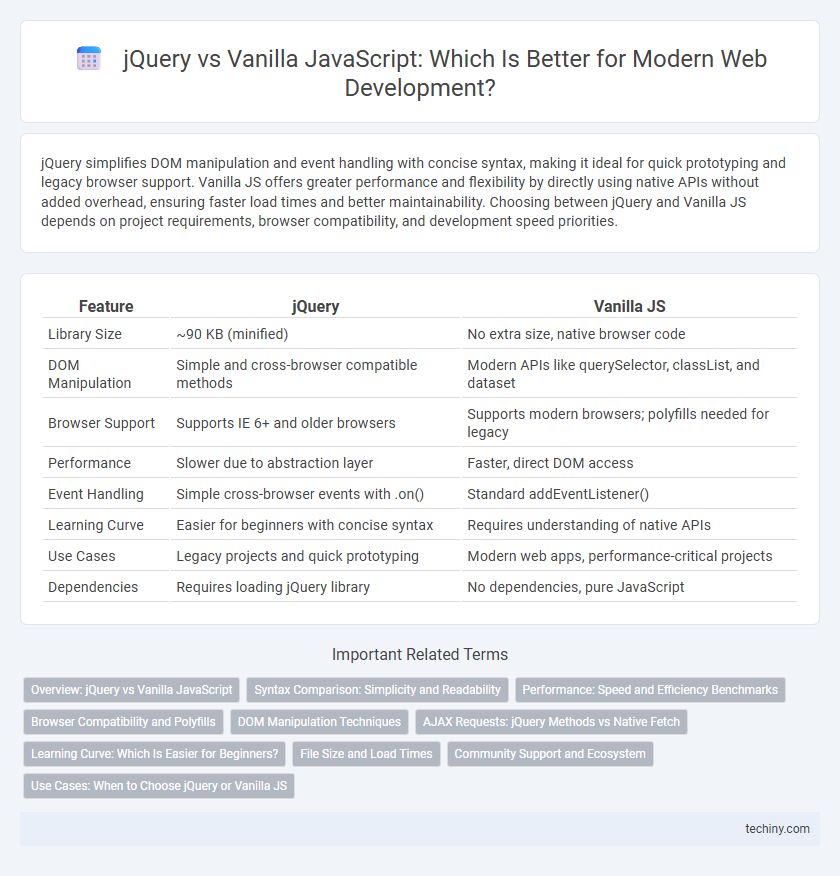jQuery simplifies DOM manipulation and event handling with concise syntax, making it ideal for quick prototyping and legacy browser support. Vanilla JS offers greater performance and flexibility by directly using native APIs without added overhead, ensuring faster load times and better maintainability. Choosing between jQuery and Vanilla JS depends on project requirements, browser compatibility, and development speed priorities.
Table of Comparison
| Feature | jQuery | Vanilla JS |
|---|---|---|
| Library Size | ~90 KB (minified) | No extra size, native browser code |
| DOM Manipulation | Simple and cross-browser compatible methods | Modern APIs like querySelector, classList, and dataset |
| Browser Support | Supports IE 6+ and older browsers | Supports modern browsers; polyfills needed for legacy |
| Performance | Slower due to abstraction layer | Faster, direct DOM access |
| Event Handling | Simple cross-browser events with .on() | Standard addEventListener() |
| Learning Curve | Easier for beginners with concise syntax | Requires understanding of native APIs |
| Use Cases | Legacy projects and quick prototyping | Modern web apps, performance-critical projects |
| Dependencies | Requires loading jQuery library | No dependencies, pure JavaScript |
Overview: jQuery vs Vanilla JavaScript
jQuery is a fast, small, and feature-rich JavaScript library designed to simplify HTML document traversal, event handling, and animation with an easy-to-use API compatible across browsers, while Vanilla JavaScript refers to using plain JavaScript without any libraries or frameworks. jQuery abstracts many complex tasks into concise methods, reducing cross-browser inconsistencies, but Vanilla JavaScript offers greater control, smaller file sizes, and improved performance by eliminating the overhead of additional libraries. Modern browser advancements and ES6+ features have narrowed the gap, making Vanilla JavaScript more viable for developing efficient, maintainable web applications without relying heavily on external dependencies like jQuery.
Syntax Comparison: Simplicity and Readability
jQuery simplifies DOM manipulation with concise syntax like `$('#element').hide()`, enhancing readability and reducing code length compared to Vanilla JS's `document.getElementById('element').style.display = 'none'`. Vanilla JS promotes modern ES6+ features such as template literals and arrow functions, providing clear and maintainable code without library dependencies. Choosing between jQuery and Vanilla JS depends on project requirements, with Vanilla JS often preferred for performance and minimalism in contemporary web development.
Performance: Speed and Efficiency Benchmarks
Vanilla JS outperforms jQuery in speed and efficiency, as it directly interacts with the DOM without the abstraction overhead jQuery introduces. Performance benchmarks consistently show that native JavaScript executes faster, reduces memory usage, and results in smaller payload sizes compared to jQuery. Developers aiming for optimal web performance prioritize Vanilla JS to minimize load times and improve responsiveness.
Browser Compatibility and Polyfills
jQuery offers broader browser compatibility by abstracting inconsistencies across older browsers, eliminating the need for developers to write complex code for each environment. Vanilla JS requires the use of polyfills, such as core-js or polyfill.io, to ensure modern JavaScript features work seamlessly in legacy browsers like Internet Explorer 11. Choosing jQuery can reduce compatibility issues without additional dependencies, but leveraging Vanilla JS with targeted polyfills results in leaner, more performant web applications.
DOM Manipulation Techniques
Vanilla JS offers direct DOM manipulation through methods like querySelector, createElement, and addEventListener, providing faster performance due to no dependency overhead. jQuery simplifies DOM traversal and manipulation with functions like $(selector), .append(), and .on() that handle cross-browser inconsistencies automatically. Developers choose Vanilla JS for lightweight projects and jQuery when prioritizing ease of use and legacy browser support.
AJAX Requests: jQuery Methods vs Native Fetch
jQuery simplifies AJAX requests with methods like $.ajax(), $.get(), and $.post(), providing easy-to-use syntax and built-in error handling for asynchronous data fetching. Native Fetch API offers a modern, promise-based approach with greater flexibility, allowing complex configurations and better integration with async/await syntax. Compared to jQuery, Fetch reduces dependency size and leverages browser-native capabilities, enhancing performance and control over network requests in web development.
Learning Curve: Which Is Easier for Beginners?
Vanilla JS offers a steeper learning curve as it requires understanding core JavaScript concepts like DOM manipulation, event handling, and asynchronous programming. jQuery simplifies these tasks with its easy-to-use syntax and built-in methods, making it more accessible for beginners. However, mastering Vanilla JS builds a stronger foundation for advanced web development skills and modern frameworks.
File Size and Load Times
Vanilla JS typically results in smaller file sizes since it doesn't require loading an external library like jQuery, which is around 90KB minified and gzipped. This reduction in payload directly improves load times, especially on mobile networks or slower connections. Choosing Vanilla JS can lead to faster initial rendering and better overall performance by minimizing HTTP requests and resource overhead.
Community Support and Ecosystem
jQuery boasts a vast and mature community with extensive plugins and libraries, making it easier to find solutions and resources for web development challenges. Vanilla JS, while relying on the broader JavaScript ecosystem, benefits from modern browser APIs and growing support in frameworks, offering lightweight and performant alternatives without external dependencies. Developers often choose jQuery for rapid development and legacy support, whereas Vanilla JS is preferred for flexibility and future-proof projects within evolving web standards.
Use Cases: When to Choose jQuery or Vanilla JS
jQuery is ideal for rapid prototyping and projects requiring extensive DOM manipulation or cross-browser compatibility, especially in legacy systems. Vanilla JS excels in performance-critical applications and modern browsers where lightweight, dependency-free code enhances load speed and maintainability. Choosing between them depends on project complexity, browser support needs, and developer familiarity with JavaScript frameworks.
jQuery vs Vanilla JS Infographic

 techiny.com
techiny.com